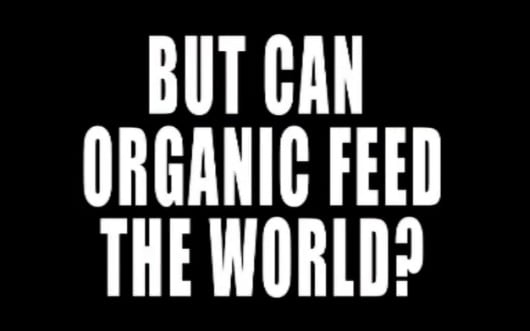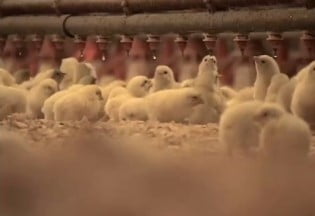
 How many of you have heard about all of the problems with organic and sustainable farming practices, and that it just isn't possible to keep it going long term? That it's too difficult, and too costly?
How many of you have heard about all of the problems with organic and sustainable farming practices, and that it just isn't possible to keep it going long term? That it's too difficult, and too costly?
“There is no reason for a confinement house in the country, in the world, ANYWHERE! Know your farmer, and just completely opt out of the system.”
Joel Salatin and his books offer so much hope! This one looks good: You Can Farm: The Entrepreneur's Guide to Start & Succeed in a Farming Enterprise. I hope more of you become farmers and part of the solution, because we all need you!
Watch the American Meat film trailer below and share your thoughts!
- See more food movie trailers
- Opt out in more ways by buying from sponsors on my resources page who are doing things the right way.
- Learn more about American Meat



Jenny says
End the subsidies and grass fed beef will be normal. It’s not at all like converting the country from gas to electric cars. The infrastructure is already there. It doesn’t require that much change. Most farmers here plant soy because it pays better than hay. They go where the money is. Most cattle are still grass fed until they get bought up for the feed lot, they only change is how long they would remain on grass. Fields not planted to soy would be converted to hay or grazing…only takes a season or two.
Speaking from experience, GRASS PRODUCTION IS MORE PRODUCTIVE THAN ROW CROPPING. Cattlemen sell their calves at 6 months because that’s the best price/lb, not because they can’t keep them longer.
Aneesa says
The question of whether small, organic, diversified farming can feed the world is one that always tickles me. People ask the question as if this method of farming is something new and contemporary while factory farming is the traditional model?!!! “Organic” farming via diversified farming methods has been sustaining the world’s people since the beginning of time. Big Ag is the real new kid on the block. Seems to me we are asking the wrong question. “Organic” farming has proven its sustainability in the annals of history. In other words…If it ain’t broke, don’t fix it!
Maryjane says
I believe that part of the answer lies in education — food education, that is. As more and more people learn about the health benefits of Real Food, they will have the motivation to make changes and the foundation upon which to build a new lifestyle. And as more and more people “opt out” of the system, the system will change — more and more people will become Joel Salatins, and more “Real Food” will become available at better and better prices. This is the capitalist system, BUT it will only serve its customers well if they are educated and demand high quality food.
Naomi Williams says
Don’t forget to factor in the amount of food that’s just flat out thrown away in garbage cans. I’ve seen some studies claiming that almost 50% of our food in this country is thrown out. (Seems like a high figure to me, but folks are wasteful, no doubt about it.)
Soli says
What we need is to get more people involved in the process of raising and growing their own food. We have too few farmers and an ever expanding demand. I also keep saying we need to eat more variety and that includes eating more from one animal! I see out wasting good parts of animals the same way I do the harvesting of shark fins for soup and letting the shark fall to the ocean and die. A total needless waste.
Meredith Reichmann says
Has anybody read what happened during WWI and WWII with the victory gardens? We need to change our mentality that it is the grocery store’s job to provide our food. When everybody takes responsibility for making their own food, or at least contributing to their local food supply (be it raising veggies or raising chickens, or just growing their own herbs) we will be able to feed the world!
leigh says
We get beef from my FIL every year as a Christmas gift, but he stores most of our share at his place b/c we just have a small freezer chest and can’t hold it all. I know it isn’t grass-fed and I’m almost positive he uses abx, but it’s free and hopefully still better than the stuff at the store.
What I’m needing is a way to prepare steak that I like enough to eat. We’ve tried marinades and rubs and I’m still not fond of the beefy flavor. Wish there was some other way I could make it b/c we have tons of steaks and they’re not getting eaten; at the same time I’m struggling lately to decide what to fix for supper and thinking I could be putting them to use. . .fajitas? I just don’t want to break out the grill.
Chris Kerston says
Leigh,
Do you have the same aversion to the flavor if you eat beef from a different source. Beef varies as much in flavor as wines do. Different breeds, managements systems, and types of feed will all play major factors in determining the flavor of the resulting steak. The cooking method will also make an impact on flavor. I’m curious if the result is the same on high heat like with grilling as with low heat like with a crockpot? Our ranch sells a lot of beef to all sorts of different folks. Everyone’s favorite cut tends to be the filet mignon, but of course they’re the most expensive. Dry aged meat also makes all the difference in a milder flavor. Try to get steaks aged over 14 days. I’d try to get some steaks from another suppliers and see if you can find something you like more. I don’t think you’re ever going to be able to completely mask a flavor you don’t like. At the same time you’re not going to be able to change your father-in-law’s livestock management. So even though it’s free, if you don’t like the meat it may not be the best deal for you. You can go on http://www.EatWild.com to find local ranches in your area selling grassfed beef. Some of them might offer a steak sampler package, or you might be able to just buy a few retail cuts from them.
Kendra says
Some cuts of steak that we get from our farmer are just not the same level of tenderness that we’re used to (from Fresh Market), so if I’m not ready to put them on the grill (after letting them thaw in the fridge for a few days to help dry-age), then I tend to use them for stir fry, or stroganoff.
Margaret says
It takes a total mindset change and a big freezer, to buy meat from local farmers instead of the store, but it can be done. I’ve done it. Now, I just go to my freezer to “shop” for meat for my next meal instead of the store. What most people don’t realize is that even much of the meat at the health food store is factory farmed. Being “naturally raised” or free of antibiotics and hormones does not mean that it has not been factory farmed. And that meat is still finished on corn and soy as well. The stuff that is 100% pasture-raised (some lamb and grassfed beef) is horribly expensive at the store. The only affordable way to eat pastured meat is to buy a whole, half or quarter animal (depending on size of animal) direct from the farmer. I find even many people in the local WAPF chapter are unwilling to invest in a large freezer and buy direct from the farmer. They have a hard time making the mindset change and they say they can’t afford a freezer or can’t afford to buy that much meat at one time. It is more expensive upfront but it saves so much money long-term. I know of someone in an apartment who has a chest freezer in her bedroom. So if someone puts their mind to it, they can do it. I have 2 upright freezers for convenience but chest freezers can be gotten cheap, or sometimes even free, if someone cannot afford an upright.
leigh says
I think if people had no other option, they’d FIND a way to make true organic farming work and support it. It seems to me that eating and living this way would really enhance people’s sense of community. Eating together holds the deepest meaning in the Scripture and I think this kind of lifestyle certainly speaks to that.
Linda says
I think it is possible, but more people need to feel the way we do. What someone in the trailer said, we need to get back to our roots. I agree with that. So many more people need to understand that the meat they buy in the grocery (for the most part) comes from factory farms. I don’t even think they understand how bad factory farms are. They also don’t get the relationship between the food they eat and their health.
My neighbor just came home from the hospital with an irregular heartbeat. His wife wants to eat the way we do, but didn’t know how to begin. I suggested she start by changing the cooking oil she uses. We went shopping together and she bought organic butter and eggs and coconut oil. Her husband looked at it and asked what was wrong with what they were buying. There’s nothing wrong with it. He doesn’t want to change and he won’t eat it. A lot of people have that mindset. I hope that eventually more and more people will see the light and they too will opt out.
Peggy says
I think it is possible, but it will require a major reset in our thinking. We have become so accustomed to food out of season, on demand, at unsustainably low prices for so long that the shift to slow, sustainable farming practices could really sting for a while. It took my family almost a year to transition to clean food, to find room in the budget and schedule for it all. But once we did, we were buffered against things like the drought. Grocery store prices are rising quickly as the corn and soy America has relied on for so long shrivels in the field. But my grass farmer isn’t raising her prices. She doesn’t need to because her grass still grows, her sustainable practices are resistant to the drought.
No, she can’t feed millions or even thousands. But she can teach what she knows to any who have ears to hear. We need a generation of farmers to learn! Sadly, with the lack of respect the base of our society receives (farmers, mothers, teachers…those who provide the basic services we truly can’t live without) there are few interested in fighting both the elements and society.
/soapbox